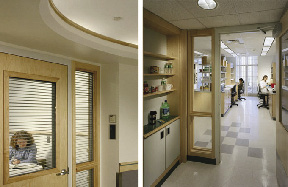Imagine taking a portion of a medical research building constructed in the 1920s and converting it into a sustainable lab. Without destroying its historic character or disrupting the daily routines of occupants above, below and within the designated space under reconstruction. And while conforming to national standards for Leadership in Energy and Environmental Design (LEED) certification.
Such was the challenge presented to "green" architectural firm, Svigals + Partners, by the Yale University School of Medicine in 2004. The project in question, the first floor of Sterling Hall's I-Wing, was completed in September 2006 at a cost of $6.8 million and awarded LEED-CI Gold certification in late spring 2008.
It is the second laboratory renovation at the Yale School of Medicine on which Svigals + Partners has collaborated and the second to be awarded LEED Gold. The first, the third floor of Sterling Hall's c-wing, set a national precedent as the country's first LEED Commercial Interiors (CI)-certified renovated lab. It also established the standard by which all lab renovations at Yale and elsewhere in the country would be judged henceforth.
According to Robert Skolozdra, project architect and partner, Svigals + Partners, the I-Wing first floor project pitted the firm's ingenuity and sustainable design expertise against the realities of the school's early 20th century architecture, which was never originally intended to contain advanced utility, communication or fire protection systems; nor world-class facilities housing Zebra fish, PCR tools, DNA analyzing equipment, electron microscopes or mass spectrometers.
"The 19,816 s/f space, now used by Yale's Genetics Department, was initially characterized by 12-foot floor to floor spaces (compare that to today's typical 15-foot commercial spaces); single-glazed windows; minimal HVAC systems; and antiquated and/or non-existent plumbing, fire protection, telephone, data and electrical systems. The building's geometry was a challenge because windows were not necessarily spaced to match the ideal configuration of the laboratory. This was critical since we were attempting to maximize the views from each occupied seat. To further complicate matters, angles of greater or less than 90 degrees had to be incorporated into the design," Skolozdra said.
Yale's goal, indicated Skolozdra, was to completely transform the floor's pre-World War II, non-contiguous rooms and obsolete research spaces into a cutting-edge environment designed to attract the world's best and brightest scientists.
The revamped I-Wing space consists of four large, open-design wet bench laboratories, and provides light-filled offices and common facilities for faculty, staff, visitors, fellows and students. Previously under-utilized rooms have been converted into efficient laboratory space with new modular casework, glass partitions and mechanical and data systems.
In designing the new Genetics Department, Svigals + Partners worked to significantly increase the number of workspaces offering access to views and daylight.
Laboratory and office spaces were carefully balanced to achieve the most efficient and most highly collaborative configuration. Offices are grouped with break, conference and informatics areas, and the amount of glass in the hallways encourages researchers to meet and mingle informally. Offices that were previously enclosed within research spaces now feel open and inviting.
Additionally, the I-Wing first floor features an advanced light control system and special ceilings. Daylight sensing allows optimal energy use, occupancy sensing and lighting controllability, and the maximizing of windows and views ensures that more than 90 percent of lab occupants have views and access to daylight.
Moreover, Svigals + Partners specified furnishings, flooring, fabrics, and even insulation and adhesives that met strict sustainable requirements:
*Easily recycled when the building becomes obsolete.
*Previously recycled materials.
*Materials crafted from rapidly renewable resources - such as wheat and bamboo that can be grown and harvested in a single season.
*Materials that don't emit noxious gases.
*Materials secured from sources within 500 miles of the project site.
Tags:
Svigals + Partners and Yale University earn LEED Gold for the renovation of the new Genetics Department building
October 15, 2008 - Green Buildings







